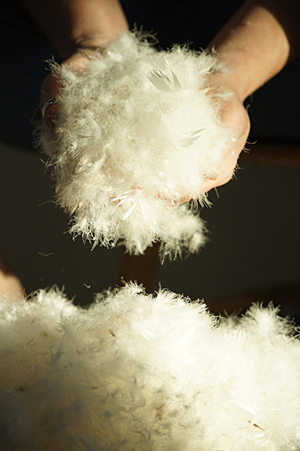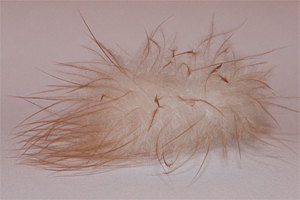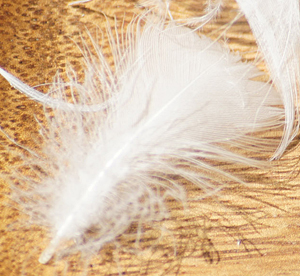
A handful of down insulation (Image courtesy of Downlite)
Both down and synthetic insulation have their advantages and disadvantages. Which is “best” for outdoor use depends on your needs, preferences, and budget.
To pick the right one for your backcountry adventures, you first need to understand what down and synthetic insulation are and what they do.
- Down Insulation: what it is, properties, loft, fill power, pros and cons
- Synthetic Insulation: what it is, properties, loft, short staple and continuous, pros and cons (separate article)
Down Insulation
What It Is
Down is composed of down clusters and feathers that are produced by geese, ducks, and other waterfowl to keep them warm.
Down clusters are tiny, fine, fluffy feathers from the birds' undercoats. They resemble tiny, fuzzy asterisks and have no quill shaft.
Feathers are more familiar in size and shape and have a quill shaft.
Better down insulation contains a higher ratio of clusters-to-feathers. A product is required to contain a minimum of 75 percent down clusters to be labeled as down.
Properties

Down cluster (Image: Yoky/Wikimedia Commons)
Down is considered the best natural insulator, thanks to its millions of fluffy filaments that form tiny air pockets to trap your heat.
Down is resilient, retaining its shape and insulating power for years, and is typically more expensive than synthetic. So buying a down sleeping bag or jacket can be more of an investment than buying a synthetic version.
Down loses loft and stops insulating when wet, so it's traditionally been a poor choice in wet conditions. However, new technologies, like DownTek and DriDown, apply nano polymer finishes to down plumes to repel water while maintaining down's high loft, insulation, and breathability, even when wet.
Many sleeping bag manufacturers also use water-resistant fabric to keep moisture out. You can save money with a bag that lacks a water-shedding shell, but you'll have to be extra careful about keeping it dry.
Loft
Loft measures how much space the insulation takes up, and therefore, how much air it can trap. The more puffiness, or loft, the down has, the warmer it is. More mature birds typically produce down with greater loft for greater warmth.
Fill Power

Down feather (Image courtesy of Downlite)
As you compare down sleeping bags and jackets, you'll see a rating called fill power. Fill power measures the amount of space, in cubic inches, occupied by one ounce of down. For example: 700 in³/oz (aka 700 fill) means that one ounce of a given sample of down occupies 700 cubic inches.
The higher the fill power, the warmer and more compressible a given quantity of down is.
Fill power is a key number for backpackers, because a four-pound sleeping bag with a high fill power (ex. 800 fill) will be warmer and more compressible than a four-pound bag with a lower fill power (ex. 550 fill).
Fill power ratings above 800 represent the peak of thermal efficiency. Higher fill powers usually mean a higher price tag, but bags with high fill powers are light, compressible, and warm. Fill powers can reduce over time with use, but can be restored with proper care and cleaning.
Pros
- Best natural insulator
- Warmer ounce for ounce
- Lighter
- More breathable
- More compressible
- Holds shape
- Longer lasting
Cons
- Loses insulating properties when wet (unless specially treated)
- Longer dry time
- More expensive
- More care needed in cleaning
- Not for vegans
Also, see "Gear Explained: Synthetic Insulation"
(With reporting by Seth Levy and Alicia MacLeay)

 by Heather Sable
by Heather Sable









